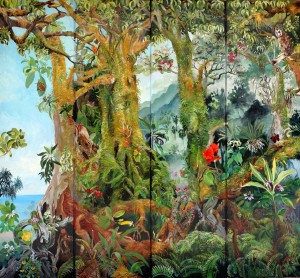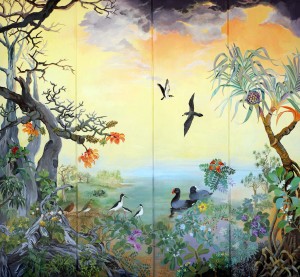Panel I

Ka Wao Koa o ke Ko‘olau
Koa Upland of Ko‘olau
In Hawai‘i, rapid changes in elevation and moisture produce unique ecological conditions.
On the windward side of the Hawaiian Islands, northeast tradewinds bring moisture from the Pacific Ocean. As these winds meet the steep Ko‘olau cliffs, they are forced upward to cool, higher elevation, forming clouds and rainfall.
Thus, the windward ecosystems of Oahu change rapidly from the dry coast to the wet Ko‘olau summit. Nehe, naupaka and hala forest are found along the dry coasts, and in the lowlands. Further inland, koa trees dominate the mesic (neither wet nor dry) forests along with kōlea, ili‘ahi, pūkiawe, ‘a‘ali‘i and ‘ala‘alawai nui, a succulent herb. Above the mesic forests, the wet Ko‘olau cliffs rise into the clouds. Dominated by ‘ōhi‘a, this much wetter forest supports a variety of ferns and shrubs, such as endemic lobelioids.
Panel II Ka Wao Lipo o Ka Manu
Ka Wao Lipo o Ka Manu
Deep Upland of Birds
At the summit of the Ko‘olau mountains, the forest is wet and lush. The great diversity of native trees, shrubs, ferns, herbs, and mosses together form a complex, layered structure that pulls moisture from the air, absorbs the erosive energy of falling raindrops, and allows gradual percolation of water into the ground and into underground acquifers.
‘Ōhi‘a lehua, māmaki, ‘ōhelo, pū‘ahanui, hāhā and ‘ōhāwai are found here. Native fern such as hapu‘u, hoe a Māui, oāli‘i makali‘i, and laukahi grow lushly. Many species of delicate and filmy fern and liverworts cover tree branches in the water-saturated air. ‘Ie‘ie, a native liana, spirals up tree trunks.
Lanalana-the happyface spider, pulelehua-the Kamehameha butterfly, the kāhuli-beautiful tree snails, many kinds of long horn beetles. and other native invertebrates reside here.
The movement of the ‘apapane, ‘i‘iwi, akialoa, ‘amakihi, ‘ākepa, ‘elepaio, ‘ō‘ō, and other native birds add color and wonderful song to this ecosystem.
Panel III
 Ka Pali Lele Pueo
Ka Pali Lele Pueo
Pueo Flight Cliff
On the Kona (leeward) side of the Ko‘olau mountains, steep-sided long ridges such as the one that runs from Lanihuli down towards Kapālama, provide a home for a wide variety of plants and animals . At the wet summit, mossy branches of ‘ōhi‘a shelter the koli‘i. Descending to lower elevation and drier mesic settings, koa forests, māmane, naio, and loulu palms are found. Here, ferns are less common and the understory is dominated by native shrubs such as manono, naupaka, ‘akoko, pilo, and pūkiawe.
The pueo, our day-flying native owl, soars over dry forest and shrubland.
‘O‘opu and pinao ‘ula, the red Hawaiian damselfly, are examples of native species living in streams that run through wet valleys such as Nu‘uanu and Kalihi.
Panel IV

Ka Loko Wai ‘Olu‘olu
Pleasant Pond
The lowlands of the leeward coast are dry where forests of wiliwili, kou, and halapepe grow. Coastal shrubs such as naio, ma‘o, ‘ilima, naupaka, beach ‘iliahi, ‘ohai, pā‘ū o Hi‘iaka, and hinahina are found on sand and limestone flats.
Along the coastal flatlands, groundwater springs provide water and create wetlands. ‘Alae ‘ula ,‘alae ke‘oke‘o, ae‘o, and other native waterbirds flourish. Hala groves predominate at the edges of wetlands.

23 Responses to The Panels